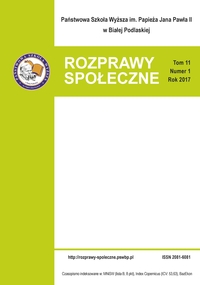Częstotliwość powikłań występujących u osób w podeszłym wieku chorujących na cukrzycę, objętych opieką pielęgniarki środowiskowej
The incidence of diabetes complications in elderly patients under the community nursing care
Author(s): Izabela Wróblewska, Małgorzata Dziechciaż, Piotr Oleśniewicz, Zuzanna Wróblewska, Dorota Talarska, Jerzy ZagórskiSubject(s): Health and medicine and law
Published by: Państwowa Szkoła Wyższa im. Papieża Jana Pawła II w Białej Podlaskiej
Keywords: elderly patients; diabetes; healthcare; nurse
Summary/Abstract: Medical documentation of 4680 patients of an individual nursing practice in Jarosław, Poland, was analyzed statistically. The inclusion criteria of the conducted research were patients age ≥60 years with type 2 diabetes diagnosed by a physician. The study patients were selected with the use of a diagnostic survey method, the authors’ own questionnaire, and medical documentation analysis. As a result, the study involved 170 patients. The chi-square test of independence and the Mann-Whitney test were applied to verify the differences between the variables. The majority of the studied patients were women (61.1%), in the 71–80 age group (57.6%). Irrespective of gender, diabetes was most often diagnosed in people in early senility, aged 60–70 years (62.9%). Most of the respondents received oral medications (59.4%); had a large waist circumference (92.9%), as well as high body mass index (95.3%). In the majority of the elderly, no hypoglycaemia (83.0%) or hyperglycaemia (77.6%) were recognized. However, numerous complications were diagnosed, namely dyslipidaemia (85.9%), hypertension (81.8%), macroangiopathy (90.0%), microangiopathy (71.2%), and ophthalmological diseases (25.9%). Most diabetics suffer from overweight or obesity, and long-term diabetes complications. Analyzing the incidence of diabetes and its complications should help to outline further actions that need to be taken to diagnose and prevent the disease in order to detect its complications early and prolong the patients’ survival as well as raise their quality of life.
Journal: Rozprawy Społeczne
- Issue Year: 11/2017
- Issue No: 1
- Page Range: 87-92
- Page Count: 6
- Language: English

